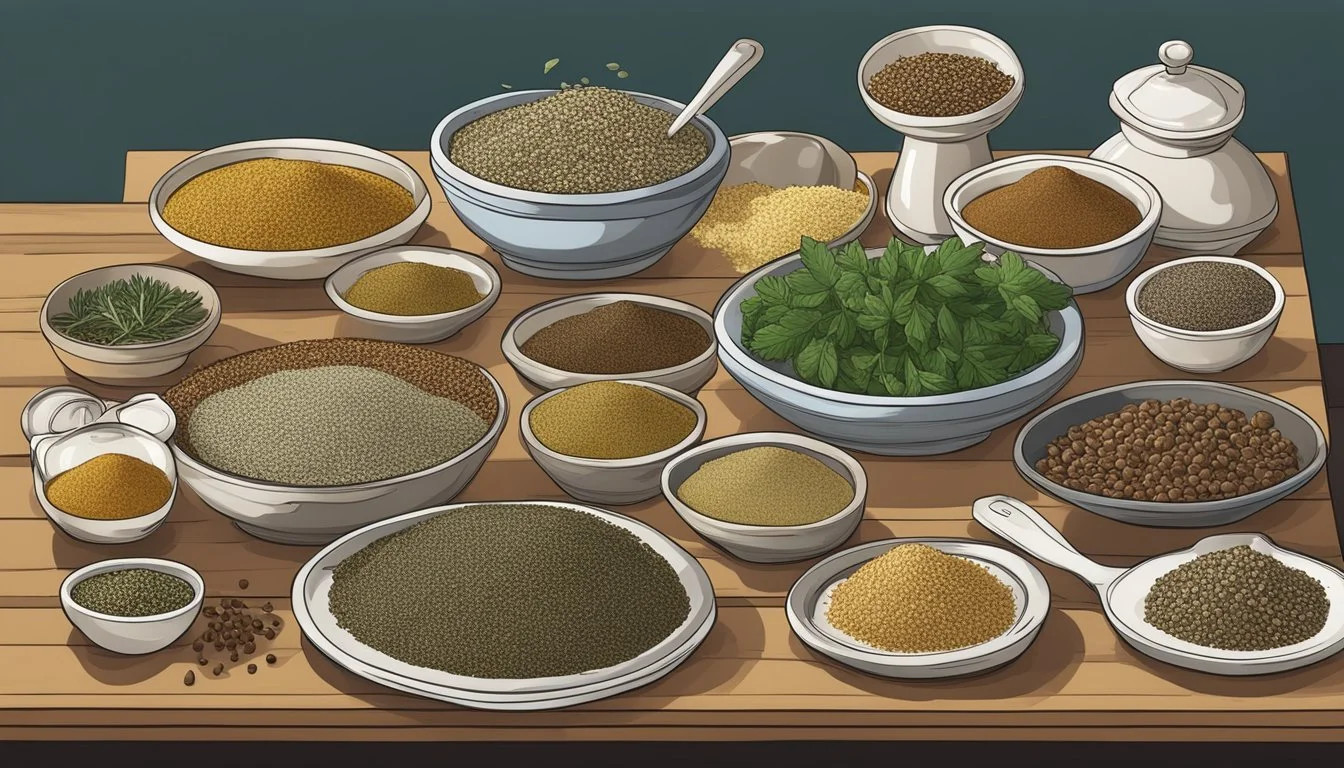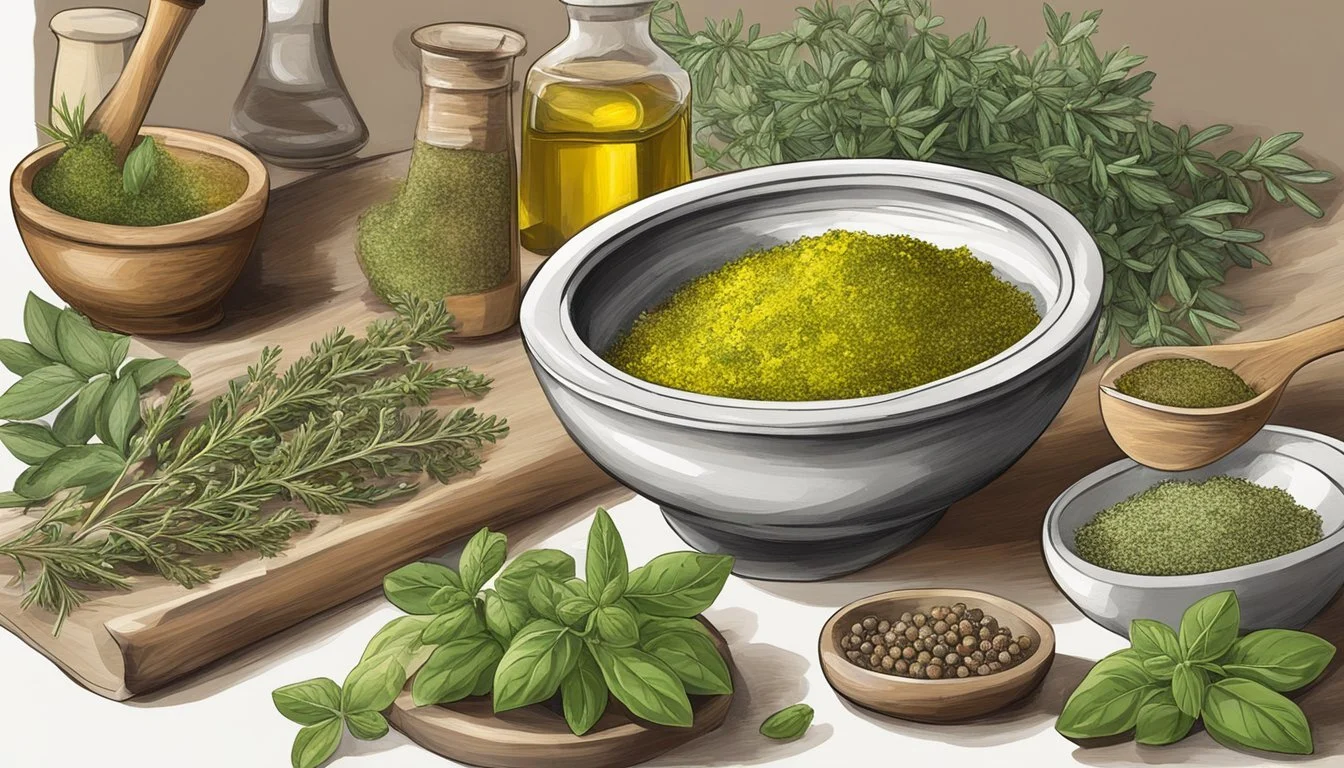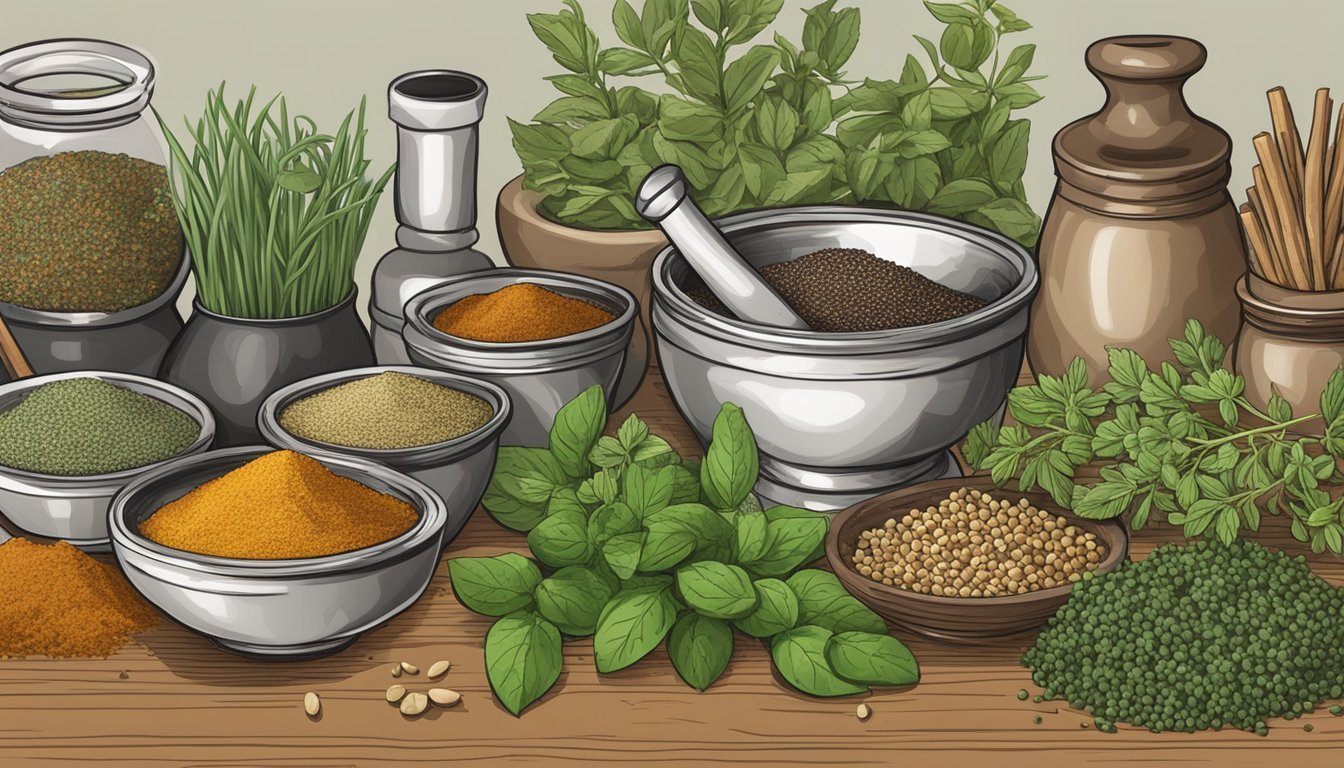Za'atar Substitutes
Best Alternatives for Authentic Flavor
Za'atar, a staple in Middle Eastern cuisine, is cherished for its herbaceous flavor that enriches various dishes. Combining thyme, sesame seeds, oregano, and sumac, za'atar delivers a unique flavor profile that can be tricky to replicate. When you find yourself without this versatile blend, you can turn to several effective substitutes like a homemade mix of dried oregano, sesame seeds, and sumac or use ground coriander for a citrusy alternative.
Middle Eastern cuisine often relies on the depth of flavors that za'atar provides. For a quick fix, fresh thyme or fresh oregano can mimic some aspects of the traditional spice mix. Alternatively, using mixed herbs with sesame seeds and a bit of lemon zest can offer a near-authentic taste experience.
For those seeking a more adventurous option, harissa spice powder serves as a robust alternative, bringing a different but complementary flavor to dishes. Each substitute carries its own distinct qualities but remains capable of delivering the rich, herbaceous notes characteristic of za'atar.
Understanding Za'atar
Za'atar is a cornerstone of Middle Eastern cuisine, blending herbs, spices, and sesame seeds to create a robust, aromatic seasoning. Its historical roots and unique composition make it a versatile and cherished spice mix.
Historical Significance
Za'atar has ancient origins, tracing back thousands of years in the Middle East. It has been used in various forms by cultures from Egypt to the Levant. The earliest references mention za’atar in ancient medical texts, highlighting its valued medicinal properties.
In many Middle Eastern households, za'atar is not just a spice but a symbol of cultural heritage and tradition. It can often be found as a staple in kitchens, integrated into daily meals and special occasions. People use it as a seasoning for breads, meats, and vegetables, linking culinary practices with historical traditions.
Composition of Za'atar
Za'atar typically includes a mix of dried thyme, oregano, marjoram, sumac, and toasted sesame seeds. Thyme and oregano bring a fragrant, herbaceous note, while sumac adds a tangy, lemony flavor. Marjoram complements these flavors with its slight sweetness.
The sesame seeds contribute a nutty undertone and a subtle crunch. Some variations may also include a bit of salt to enhance the flavor profile further. In certain regions, the spice blend might incorporate hyssop, adding a unique earthy taste to the mix.
This balance of flavors and textures—herby, tangy, and nutty—makes za'atar perfect for a wide range of dishes, from dips to roasted vegetables and meats.
Za'atar's Culinary Uses
Za'atar, a Middle Eastern spice blend, is prized for its versatility. It enriches various dishes with its unique earthy and tangy flavor profile.
Traditional Applications
In Middle Eastern cuisine, za'atar is frequently used as a seasoning on bread. One popular preparation involves spreading olive oil on pita bread and sprinkling za'atar on top before baking. This Za'atar Bread is often served with meals or as a snack.
Za'atar also enhances meats such as chicken and lamb. It is common to use it in spice rubs and marinades, which brings out an herbaceous and slightly tangy flavor. For instance, za'atar-crusted lamb is a classic dish showcasing this blend's potential.
Vegetables like eggplant and tomatoes benefit from a sprinkling of za'atar, adding complexity to their natural flavors. Hummus, a popular dip, often gets a finishing touch of za'atar, elevating its taste profile.
Modern Adaptations
Contemporary cuisine has embraced za'atar in innovative ways. Chefs use it to season roasted vegetables, enhancing their earthiness. It’s also sprinkled over avocado toast, offering a Middle Eastern twist.
Salads often see an addition of za'atar for an exotic flair. Mixed with olive oil, it forms a quick and flavorful dressing for green and grain salads alike. This use has become especially popular in fusion cuisines.
For those looking to experiment, za'atar can be an excellent rub for grilled meats and fish, adding depth to the marinades. Even snack foods like popcorn and chips are gaining popularity with za'atar seasoning, providing a unique taste experience.
Key Component: Thyme Substitutes
When you run out of thyme, you can use several effective substitutes to maintain the flavor in your dishes. Both dried and fresh alternatives can work, each bringing their own unique qualities to the recipe.
Substituting Dried Thyme
Dried thyme is a common pantry staple, known for its earthy and slightly minty flavor. If you need a substitute, dried oregano and dried marjoram are excellent choices. Both herbs share similar aromatic profiles with thyme and can seamlessly blend into various dishes.
Dried Oregano: More robust and slightly peppery, oregano can be used in a 1:1 ratio for thyme. Perfect for Italian dishes and any recipe requiring a strong herbaceous note.
Dried Marjoram: Slightly sweeter and more delicate than thyme, marjoram works equally well in soups, poultry, and vegetable dishes. Use it in the same amount as dried thyme.
Lemon Thyme as an Alternative
Lemon thyme provides a citrusy twist and can be a delightful alternative to traditional thyme. Its lemon-scented leaves make it a versatile herb in many recipes.
Adds a fresh lemony note to chicken, fish, and vegetable dishes.
Enhances salads, marinades, and dressings with a bright, tangy flavor.
When substituting:
Use lemon thyme in the same quantity as you would regular thyme.
Works especially well in Mediterranean and Middle Eastern cuisines where a hint of citrus can complement other flavors.
Sumac's Unique Role and Replacements
Sumac brings a distinct citrusy flavor and vibrant red hue to dishes. Finding the right substitute ensures you maintain that tangy zest.
Sourcing Sumac
Sumac is prized for its tartness. Derived from the berries of the Rhus plant, it is dried and ground into a fine powder. This spice is commonly used in Middle Eastern cuisine to add a citrus-like tang without the acidity of lemon juice. It's essential in many dishes, from salads to grilled meats.
Sumac powder is often available at specialty food stores and online. For those who struggle to find it locally, checking Middle Eastern markets or ordering from reputable online retailers can be helpful. Fresh sumac berries, when in season, are also an option, though they require proper preparation.
Alternatives to Sumac's Tartness
When sumac isn't available, there are several alternatives that replicate its citrusy flavor.
Lemon Zest: Grating the skin of a lemon provides a similar texture and tartness. It is an excellent replacement, especially for sumac's bright notes.
Lemon Pepper: Combining lemon zest and black pepper, this seasoning approximates sumac’s tart and peppery flavor. Some blends include salt, which enhances the overall taste.
Tamarind: Known for its tanginess, tamarind paste or powder can serve as a substitute. It adds a similar depth of flavor to dishes.
Vinegar: A few drops of vinegar can mimic sumac's acidity in recipes. While it lacks the specific flavor, it provides the required sour note.
Orange Peel: Drier and slightly sweeter than lemon zest, it still offers a citrusy kick. It pairs well in recipes needing that zesty element.
Za'atar, a blend containing sumac, can also be used directly. This mixture includes thyme and toasted sesame seeds, adding complexity to your dish while maintaining a hint of sumac. Using a blend can offer more than single spice substitutes, creating diverse flavor profiles.
Identifying Sesame Seed Alternatives
Finding good substitutes for sesame seeds involves considering both their nutty flavor profile and the way toasted sesame seeds enhance dishes. Alternatives should replicate these characteristics as closely as possible.
Nutty Flavor Profiles
Hazelnuts offer a rich, nutty flavor that can stand in for sesame seeds. Finely chop or grind them to a size similar to sesame seeds for a comparable texture. Their robust taste adds depth to baked goods and salads.
Almonds also serve as a suitable alternative. Sliced or slivered almonds can be sprinkled on top of dishes, providing a mild nuttiness. Their versatility makes them a good replacement in many recipes.
Sunflower Seeds can mimic sesame seeds' subtle nuttiness. Lightly toast them to bring out their flavor before adding them to the dish. They are especially good in salads and breads.
Toasted Sesame Seeds Mimics
Toasted Pine Nuts replicate the rich, toasted flavor of sesame seeds. Their creamy texture and buttery flavor make them a standout in sauces and pestos.
Chia Seeds offer a similar crunch and can be toasted to enhance their flavor. Although they have a milder taste, they work well in both sweet and savory dishes.
Toasted Flaxseeds bring a robust, nutty flavor when ground and toasted. They provide a satisfying crunch to smoothies, baked foods, and granola.
Cumin Seeds toasted lightly can also substitute for the rich, toasted taste of sesame seeds. They have a distinct, warm flavor that complements many spice blends and roasted vegetables.
Exploring Substitutes for Oregano
Different spices and herbs can effectively replace oregano in a variety of dishes. These substitutes can closely match the flavor of oregano or serve as dried alternatives.
Matching Oregano's Flavor
Marjoram is a close relative of oregano with a milder and sweeter taste. It complements many dishes where oregano is traditionally used.
Italian Seasoning often contains oregano, along with other herbs like basil, rosemary, and thyme. This blend can effectively replace oregano in Italian dishes.
Thyme is herbaceous and slightly minty, making it a good stand-in for oregano. It works well in roasted vegetables and grilled meats.
Choosing Dried Oregano Alternatives
When fresh oregano isn't available, dried substitutes can be an excellent option.
Dried Marjoram mirrors fresh marjoram and has a gentle flavor profile. It's a suitable replacement, especially in Mediterranean cuisine.
Mixed Herbs combine several dried herbs, including oregano. This mixture is versatile for soups, stews, and sauces.
Rosemary offers a robust, pine-like flavor. While distinct, it can introduce a unique twist to recipes calling for oregano.
Crafting Your Own Za'atar Blend
Creating your own za'atar blend allows you to customize flavors to your taste. This homemade spice mix, essential in Middle Eastern cuisine, blends key ingredients like thyme, sesame seeds, and sumac, ensuring a fresh and personalized seasoning.
Combining Spices and Herbs
To craft za'atar, start with dried thyme, oregano, and marjoram, each bringing unique herbal notes. Sumac, a tangy, lemony spice, adds zest and depth. Toasted sesame seeds introduce nuttiness and texture.
Enhance the mix with a pinch of salt for balance and red pepper flakes for heat, if desired. Some recipes also include ground coriander and a dash of cumin for additional layers of flavor. Lemon zest can be added for extra brightness.
Homemade Zaatar Proportions
For a basic za'atar blend, use:
1 tablespoon dried thyme
1 tablespoon dried oregano
1 tablespoon dried marjoram
1 tablespoon sumac
1 tablespoon toasted sesame seeds
Salt and pepper to taste
Mix these ingredients thoroughly. Adjust the quantities to suit your palate, keeping a 1:1 ratio for the main herbs and sumac. Optionally, integrate ground coriander and lemon zest in small amounts, modifying based on taste preference.
Store the blend in an airtight container to maintain freshness. This versatile seasoning enhances breads, dips, and roasted vegetables, delivering authentic Middle Eastern flavors straight from your kitchen.
Flavor Enhancements and Variations
Enhancing the flavor profile of za'atar substitutes involves incorporating additional spices and leveraging various herbs for added depth. These elements create a unique blend that can elevate your dishes.
Incorporating Additional Spices
Incorporating additional spices can significantly boost the flavor of za'atar substitutes. Garlic powder and paprika are excellent choices for adding complexity. Garlic powder brings a savory edge, while paprika introduces a mild, smoky sweetness.
Harissa spice blend is another option. It combines chili peppers and spices, delivering warmth and zest. Pepper flakes or chili flakes add a spicy kick, perfect for those who enjoy heat. Dukkah, a mix of nuts, seeds, and spices, offers a crunchy texture and earthy flavor.
Leveraging Herbs for Depth
Mint, sage, and parsley are herbs that enhance za'atar substitutes by adding fresh, green notes. Mint provides a cool, refreshing taste, while sage contributes a slightly peppery flavor with hints of lemon. Parsley offers a bright, clean herbaceous quality.
Combining these with classic za'atar components like thyme and oregano ensures a well-rounded profile. These herbs complement each other and add complexity. For an extra layer of flavor, experiment with a touch of rosemary or basil, which can provide a more robust herbal component.
Global Influence on Za'atar Substitutions
Za'atar, a renowned Middle Eastern spice blend, has found substitutions worldwide influenced by various culinary traditions. These substitutions not only retain the core flavors but also introduce unique regional twists.
Mediterranean Inspirations
Mediterranean cuisine offers rich alternatives to za'atar. Italian seasoning, a blend of oregano, basil, rosemary, and thyme, provides an aromatic profile comparable to za'atar. The use of thyme is particularly noteworthy as it offers a similar herbaceous and slightly floral taste.
Dukkah, another Mediterranean alternative, originates from Egypt. It combines seeds, nuts, and spices, creating a texture akin to za'atar, while adding a nutty dimension. Both of these blends emphasize the Mediterranean's influence on za'atar substitutes.
Beyond the Middle East
Global culinary traditions introduce other exciting substitutes. In Indian cuisine, spice blends like garam masala or panch phoron can serve as substitutes due to their complex spice profiles. Each blend brings a unique fusion of flavors.
Japanese spice blend Shichimi Togarashi (or Schimi Togarashi) showcases an intriguing alternative. This mix of seven spices, including chili pepper, orange peel, and sesame seeds, offers a tangy and spicy twist that mirrors za'atar's complexity. Substitutions from diverse cuisines demonstrate how za'atar's essence is captured and reinterpreted worldwide.
Pairing Za'atar Substitutes with Foods
Za'atar substitutes can be versatile, enhancing a variety of dishes from vegetarian to meat and seafood. Each substitute brings unique flavors, ensuring your meals remain flavorful and satisfying.
Best Matches for Vegetarian Dishes
Za'atar substitutes like thyme, oregano, and sesame seeds blend well with vegetables and salads. For roasted or grilled vegetables, thyme adds a herby note, while sesame seeds provide a nutty crunch.
Rice and pasta gain depth from these substitutes. Mix ground coriander and sesame seeds into rice for a lemony, nutty flavor. Oregano and thyme can uplift pasta sauces, giving them an aromatic boost.
In soups, the earthiness of sesame seeds combined with oregano can introduce a comforting and rich aroma. Incorporating these substitutes into salads can transform simple greens into a flavorful experience. A sprinkle of sumac adds tanginess.
Enhancing Meat and Seafood
Meat rubs benefit significantly from za'atar substitutes. For beef, combining thyme with toasted sesame seeds can add both herbaceous and nutty notes.
Chicken and lamb dishes can be elevated by a mix of oregano and sumac. This combination delivers a blend of tangy and earthy flavors, making the meats more vibrant.
For seafood, using ground coriander and sesame seeds creates a balanced profile of lemony and nutty flavors. It works well with fish, shrimp, or scallops, providing a subtle yet distinct flavor that complements the natural taste of the seafood.
Incorporating these substitutes ensures that each dish maintains a rich and well-rounded flavor profile, even without traditional za'atar.
Conclusion: Crafting Authentic Flavors
Crafting the authentic flavors of za'atar often means understanding the composition of the seasoning itself. Za'atar seasoning typically combines dried thyme, oregano, marjoram, and sometimes sumac and sesame seeds. These ingredients create a herbaceous flavor with hints of tanginess and nuttiness.
When a suitable za'atar substitute is needed, consider common pantry herbs and spices. Thyme can effectively replace za'atar due to its similar aroma and flavor. Oregano and marjoram are also excellent choices as they add depth and complexity to dishes.
A homemade za'atar blend can be created by mixing 1 tablespoon each of dried oregano, toasted sesame seeds, and sumac powder. Salt and pepper flakes can be added according to taste. This blend closely mimics the fragrance and taste of traditional za'atar.
For a different twist, Harissa Spice Powder serves as a flavorful alternative. Derived from chili peppers, garlic, olive oil, cumin, and caraway, it brings a unique heat and spiciness, suitable for various Middle Eastern dishes, from couscous to grilled meats.
These ingredient substitutes allow for flexibility in cooking while maintaining the herbaceous and floral flavors characteristic of Middle Eastern food. Experimenting with different combinations can help in achieving the desired seasoning profile.












